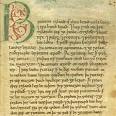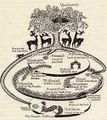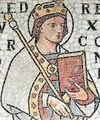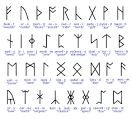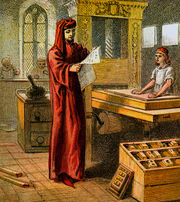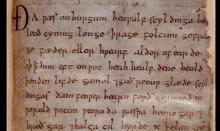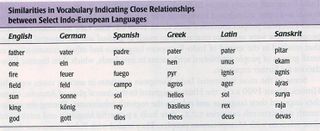Відмінності між версіями «Навчальний курс "Історія англійської мови"»
(Створена сторінка: {{subst:Шаблон:Навчальний курс}}) |
|||
| (не показані 110 проміжних версій 2 учасників) | |||
| Рядок 2: | Рядок 2: | ||
=Назва курсу= | =Назва курсу= | ||
| − | |||
| − | |||
| − | |||
| − | = | + | <p style="font-weight:bold; font-size:20pt; color:darkblue">HISTORY OF ENGLISH</p> |
| − | + | ||
| − | + | [[Файл:Image11.jpeg|300|right]] | |
| − | + | Галузь знань: 0203 Гуманітарні науки | |
| − | + | Напрям підготовки: 6.020303 Філологія. Мова і література (англійська) | |
| − | + | Факультет іноземних мов | |
| + | Освітньо-кваліфікаційний рівень: Бакалавр | ||
| − | [ | + | =Мета та завдання навчального курсу= |
| − | + | Оволодіння будь-якою мовою можливе лише за умови свідомого розуміння та засвоєння всього історичного процесу розвитку мови, усіх явищ, котрі відбулися за всі періоди її розвитку. Опанування сучасною англійською мовою неможливе без знання історичних особливостей розвитку її основних рівнів: фонетичної, граматичної будови та словниково складу. Спираючись на конкретні факти історії мови, можна прослідкувати, через які саме етапи проходив розвиток мови, які поступові зміни відбулися у граматичній та фонетичній будові, яким шляхом відбулось збагачення словниково складу. Це, а також ознайомлення студентів із походженням англійської мови, її місця у системі індоєвропейських мов у цілому та германських мов зокрема, вивчення специфічних для англійської мови особливостей утворення загальнонаціональної мови визначає основну '''мету''' курсу „Історії англійської мови”. | |
| − | + | ||
| + | |||
| + | Використання даних історії мови в практичній роботі допомагає поліпшенню та підвищенню якості викладання, сприяє проведенню навчання на належному науковому рівні. Вивчення історії англійської мови допомагає також повнішому оволодінню рідною мовою, глибшому розумінню її багатств. Отже, основними '''завданнями''' курсу є такі: | ||
| + | |||
| + | 1) розкрити закономірності розвитку англійської мови, її словникового складу, граматичної будови та фонетичної системи в нерозривному зв’язку з історією народу; | ||
| + | |||
| + | 2) підвищити загальноосвітній рівень студентів та якість їхньої філологічної підготовки; | ||
| + | |||
| + | 3) прищепити навички самостійної роботи з лінгвістичним матеріалом; | ||
| + | |||
| + | 4) розвивати особистість майбутнього вчителя як культурної, всебічно розвиненої людини, яка володіє не лише знанням сучасної англійської мови, а й орієнтується у історичних та лінгвістичних процесах, що спричинили сучасний стан певного мовного явища. | ||
| + | |||
| + | |||
| + | Після вивчення курсу студент повинен '''знати''': | ||
| + | |||
| + | 1) розвиток мови відбувається шляхом поступового відмирання елементів старої якості та поступового розвитку елементів нової якості (розпад давньоанглійської системи відмінків й заміна її використанням прийменників, тобто перехід від синтетизму до аналітизму; поступовий розпад системи сильних дієслів та її заміна системою слабких, тощо); | ||
| + | |||
| + | 2) наявність тісного зв’язку історії лексики з історією та культурою англійського народу (нові способи словотвору; запозичення як відображення внутрішніх зв’язків із сусідніми народами; глибокі зміни словникового складу мови як результат скандинавського та норманського завоювань); | ||
| + | |||
| + | 3) взаємозв’язок та взаємозалежність змін на різних рівнях мови (розвиток аналітичного типу та, як результат, фіксованого порядку слів; розвиток складної системи часових форм на тлі розвитку системи допоміжних дієслів). | ||
| + | |||
| + | [[Файл:Image000.jpeg|center]] | ||
| + | |||
| + | В основу курсу покладено досягнення сучасної лінгвістичної думки щодо проблеми історизму в мові, механізму розвитку мовних систем, синхронії та діахронії мовних явищ, взаємозв’язку та взаємодії окремих підсистем мови, системного підходу до опису мовних явищ, кореляції кількісних та якісних чинників, ролі екстралінгвістичних факторів на переломних етапах розвитку англійської мови. Опанування початковими знаннями з історії мови є першим кроком у формуванні наукового світогляду студента-мовознавця, викладача мовних дисциплін у середній та вищій школі. | ||
| + | |||
| + | |||
| + | |||
| + | |||
| + | [https://owncloud.kspu.kr.ua/index.php/s/kLtTdsuPesT8Nwk Робоча програма курсу] | ||
| + | |||
| + | [[ГЛОСАРІЙ до курсу Історія англійської мови]] | ||
| + | |||
| + | =Автор курсу= | ||
| + | |||
| + | [[Користувач:Isnisarenko|Снісаренко Ірина Євгеніївна - кандидат філологічних наук, доцент кафедри германської філології]] | ||
| − | |||
=Учасники= | =Учасники= | ||
| − | [[Сторінка координування курсу " | + | [[Сторінка координування курсу "Історія англійської мови"]] |
---- | ---- | ||
| − | |||
| − | = | + | <gallery> |
| + | Файл:Image19.jpeg|Jacob Grimm | ||
| + | Файл:Image20.jpeg|Karl Verner | ||
| + | Файл:Image10.jpeg|Periods of English | ||
| + | Файл:Image21.jpeg|Old Germanic Mythology | ||
| + | Файл:Image1.png|Indo-European Family | ||
| + | Файл:Image4.jpeg|William the Conquerer | ||
| + | Файл:Image7.jpeg|Old English Dialects | ||
| + | Файл:Image8.jpeg|Middle English Dialects | ||
| + | Файл:Image12.jpeg|Anglo-Saxons | ||
| + | Файл:Image13.jpeg|Norman Conquest | ||
| + | Файл:Image9.jpeg|William Caxton | ||
| + | Файл:Image5.jpeg|Edward the Confessor | ||
| + | |||
| + | </gallery> | ||
| + | |||
| + | =Структура = | ||
===Змістовий модуль 1=== | ===Змістовий модуль 1=== | ||
| − | + | '''Historical Development of English Phonetic System''' '''(6 години)''' | |
| + | |||
| + | '''''Тема 1: Old and Modern Germanic languages. Peculiarities of word-stress in Proto-Germanic. Vowel and Consonant Shifts. Origin of Old English Vowels and Consonants (2 години)''''' | ||
| + | |||
| + | 1. The subject matter of the history of English. Statics and dynamics in the language history. | ||
| + | |||
| + | 2. Groups of Indo-European family of languages. Old and Modern Germanic languages. | ||
| + | |||
| + | [[Файл:Futhark.png|200px|right]] | ||
| + | |||
| + | 3. The earliest period of Germanic history: | ||
| + | a) classification of Germanic tribes; b) early history of Germanic tribes; c) alphabets used by Germanic tribes. | ||
| + | |||
| + | 4. Phonetic peculiarities of Proto-Germanic: | ||
| + | a) word-stress; b) system of vowels, Germanic Vowel Shift; c) system of consonants, Germanic Consonant Shifts. | ||
| + | |||
| + | 5. The problem of periodization of the English language history. | ||
| + | |||
| + | 6. Early history of Britain: a) Germanic Settlement. Beginning of English; b) Old English kingdoms and dialects; c) Old English written records. | ||
| + | |||
| + | 7. Old English Phonetic system: | ||
| + | |||
| + | 7i. Word-stress peculiarities; | ||
| + | |||
| + | 7ii.Vowel-changes: | ||
| + | a) Independent changes. Development of Monophthongs and Diphthongs; b) Assimilative Changes: Front-Mutation, Back-Mutation, Breaking (Fracture); c) Contraction of Vowels; d) Lengthening of Vowels in certain positions; e) Changes of Unstressed Vowels. | ||
| + | |||
| + | 7iii. Consonant changes: | ||
| + | a) Voicing and Unvoicing of Fricatives; b) Rhotacism; c) West Germanic Gemination; d) Palatalization; e) Metathesis; f) Loss of Consonants in certain positions. | ||
| + | |||
| + | |||
| + | '''''Тема 2: Evolution of vowels and consonants in Middle English. The effect of the Scandinavian invasions and the Norman conquest on English (2 години)''''' | ||
| + | |||
| + | [[Файл:Image2.jpeg|180px|right]] | ||
| + | |||
| + | 1. Economic and social situation in Britain in the 11th-12th centuries. | ||
| + | |||
| + | 2. The effect of the Scandinavian Invasions on English. | ||
| + | |||
| + | 3. The Norman Conquest, its linguistic consequences. | ||
| + | |||
| + | 4. Early Middle English dialects and written records. | ||
| + | |||
| + | 5. The rise of the national English Language in late Middle English. The London dialect. The age of Chaucer. | ||
| + | |||
| + | 6. Changes in the spelling system and pronunciation. | ||
| + | |||
| + | 7. Middle English system of vowels: | ||
| + | |||
| + | 7i. Quantitative changes: | ||
| + | a) lengthening; b) shorteting. | ||
| + | |||
| + | 7ii. Qualitative changes: | ||
| + | a) levelling of unstressed vowels; b) development of stressed vowels; c) monophongization of Old English diphthongs; d) development of new diphthongs; e) rise of long vowels. | ||
| + | |||
| + | 8. Middle English system of consonants: a) development of sibilants and affricates; b) loss of consonants. | ||
| + | |||
| + | |||
| + | '''''Тема 3: Introduction of printing in Early New English. The Great Vowel shift. Other quantitative and qualitative changes of vowels. Evolution of consonants (2 години)''''' | ||
| + | |||
| + | [[Файл:1624489.jpg|180px|right]] | ||
| + | |||
| + | 1. Economic and political condition for linguistic unity in 15th-16th centuries. | ||
| + | |||
| + | 2. Introduction of Printing, its effect on the development of the language. | ||
| + | |||
| + | 3. Expansion of English over Britain. | ||
| + | |||
| + | 4. Establishment of the written standard, growth of the spoken standard. | ||
| + | |||
| + | 5. Evolution of the sound system in Early New English: | ||
| + | |||
| + | 5i. Peculiarities of word-stress. | ||
| + | |||
| + | 5ii. Changes of vowels: | ||
| + | a) in unstressed syllables; b) in stressed syllables. The Great Vowel Shift; c) qualitative changes of short vowels; d) development of new monophthongs and diphthongs as a result of Vocalization of consonants; e) quantitative changes. | ||
| + | |||
| + | 5iii. Evolution of consonants in Early New English: | ||
| + | a) growth of sibilants and affricates as a result of assimilation of lexical borrowings; b) voicing of consonants; c) loss of consonants; d) merging with a preceding consonant. | ||
===Змістовий модуль 2=== | ===Змістовий модуль 2=== | ||
| − | + | ||
| + | '''The Development of English Morphology through Diachrony (6 годин)''' | ||
| + | |||
| + | '''''Тема 4: Evolution of Nominal parts. The Noun. The Adjective. The Pronoun. The Numeral (2 години)''''' | ||
| + | |||
| + | 1. Basic grammatical features of nominal parts of speech. The Noun. | ||
| + | |||
| + | 1i. The Noun in Proto-Germanic. Word-structure, groups, declensions, grammatical categories. | ||
| + | |||
| + | 1ii. The Noun in Old English. Strong, weak, other declensions. The use of cases. | ||
| + | |||
| + | 1iii. Re-arrangement and simplification of declensions; changes in the system of grammatical categories in Middle English. | ||
| + | |||
| + | 2. The development of the Adjective. Grammatical categories. Degrees of comparison. | ||
| + | |||
| + | 3. The development of the Pronoun. Grammatical categories and main classes. | ||
| + | |||
| + | 4. The evolution of the Numeral. | ||
| + | |||
| + | [[Файл:Sample 4english.gif|420px|center]] | ||
| + | |||
| + | |||
| + | '''''Тема 5: The development of Verbal parts. Grammatical Categories and Morphological Classes of the Verb. The Adverb. The Verbals (4 години)''''' | ||
| + | |||
| + | 1. The development of verbal parts of speech. The Verb. | ||
| + | |||
| + | 1i. Verb-peculiarities in Proto-Germanic. | ||
| + | |||
| + | 1ii. Grammatical categories and morphological classification of verbs in Old English. The Verbals. | ||
| + | |||
| + | 1iii. Simplifying changes in the verb conjugation in Middle English. Morphological classes. | ||
| + | |||
| + | 1iiii. The growth of analytical forms of the verb. The Future Tense, new forms of expressing the Subjunctive Mood. Forms with “do”. | ||
| + | |||
| + | 1iiiii. The development of new grammatical categories. Passive forms. | ||
| + | |||
| + | 2. The evolution of the Adverb. | ||
===Змістовий модуль 3=== | ===Змістовий модуль 3=== | ||
| − | |||
| − | + | '''Development of the Syntactic System in English (2 години)''' | |
| − | + | ||
| − | + | '''''Тема 6: Development of the syntactic system. The phrase. The simple sentence. Compound and Complex sentences. Word order''''' | |
| − | + | [[Файл:Old english pic manuscript jf2010 1000pxk.jpg|260px|right]] | |
| − | + | ||
| − | + | 1. The development of the syntactic system in Proto-Germanic. | |
| − | + | ||
| − | + | 2. Syntactic peculiarities of Old English. | |
| − | + | ||
| + | 2i. Main types of phrases | ||
| − | + | 2ii. Ways of expressing syntactic relations. | |
| − | + | ||
| − | + | 2iii. The simple sentence: principal and secondary parts. | |
| − | + | 2iiii. Types of word-order. | |
| − | + | ||
| − | + | ||
| − | + | ||
| − | + | ||
| − | + | 2iiiii. The composite sentence: compound, complex. Mixed types | |
| − | + | 3. Changes in the syntactic structure in Middle English. | |
| − | + | 3i. Main types of connection between words. | |
| − | + | ||
| − | + | 3ii. The simple sentence in Middle English. | |
| − | + | 3iii. Significant changes of word-order. | |
| − | + | 3iiii. The composite sentence: compound, complex. | |
| − | + | 4. Peculiarities of Early New English syntax. | |
| − | ==Змістовий модуль | + | ===Змістовий модуль 4=== |
| − | + | ||
| − | + | ||
| − | + | ||
| − | + | '''Etymological Survey of the English Vocabulary (2 години)''' | |
| − | + | '''''Тема 7 : Etymological survey of the Old English Vocabulary and its further development in Middle and Early New English. History of word-formation''''' | |
| − | + | [[Файл:Indoeuropean languages1344743504907.jpg|320px|right]] | |
| − | [ | + | |
| − | + | 1. Vocabulary peculiarities of Proto-Germanic. | |
| − | + | 2. Ways of developing the vocabulary in Old English. Native and borrowed elements. Stylistic differentiation. | |
| − | + | 3. Scandinavian and French influence upon the development of vocabulary in Middle English. Borrowings from classical languages. | |
| − | + | 4. Enrichment of vocabulary in Early New English. Word-derivation and word-composition. Borrowings from other languages. Semantic changes in the vocabulary. | |
| − | ==Змістовий модуль | + | ===Змістовий модуль 5=== |
| − | + | ||
| − | + | ||
| − | + | ||
| − | + | '''Historical background of modern English Spelling (2 години)''' | |
| − | + | '''''Тема 8: Historical background of modern English Spelling''''' | |
| − | + | [[Файл:SPELL.jpg|280px|right]] | |
| − | [ | + | |
| − | + | 1. Main principles of Modern English orthography. | |
| − | + | 2. The principle of writing in Old English. | |
| − | + | 3. Spelling changes in Middle English. Rules of reading. | |
| − | [https://owncloud.kspu.kr.ua/index.php/s/ | + | 4. Historical foundation and main historical sources of Modern English spelling. |
| + | |||
| + | =Зміст курсу= | ||
| + | ==Змістовий модуль І. Назва модулю== | ||
| + | ===Тема 1: Old and Modern Germanic languages. Peculiarities of word-stress in Proto-Germanic. Vowel and Consonant Shifts. Origin of Old English Vowels and Consonants === | ||
| + | ====Теоретичний матеріал==== | ||
| + | [https://owncloud.kspu.kr.ua/index.php/s/ne9tAjFhRsa89vo Лекція №1] | ||
| + | |||
| + | ==Змістовий модуль ІІ. Назва модулю== | ||
| + | ===Тема 4: Evolution of Nominal parts. The Noun. The Adjective. The Pronoun. The Numeral=== | ||
| + | ====Теоретичний матеріал==== | ||
| + | [https://owncloud.kspu.kr.ua/index.php/s/crlkqe6GmhU6zrK Лекція №5] | ||
| + | |||
| + | ==Змістовий модуль V. Назва модулю== | ||
| + | ===Тема 8: Historical background of modern English Spelling=== | ||
| + | ====Теоретичний матеріал==== | ||
| + | [https://owncloud.kspu.kr.ua/index.php/s/wWlf3Yju4cDAlTR Лекція №8] | ||
| + | |||
| + | |||
| + | ==Тематика семінарських занять== | ||
| + | [https://owncloud.kspu.kr.ua/index.php/s/ayNkFZmDKeYoDUw семінарські заняття] | ||
| + | |||
| + | |||
| + | ==Самостійна робота== | ||
| + | [https://owncloud.kspu.kr.ua/index.php/s/r3lrmSHRfF9L2KY завдання для cамостійної роботи] | ||
| − | |||
=Ресурси= | =Ресурси= | ||
==Рекомендована література== | ==Рекомендована література== | ||
| + | [[Файл:Library-shelf.jpg|260px|right]] | ||
| + | |||
===Базова=== | ===Базова=== | ||
| − | |||
| − | |||
| − | |||
| + | 1. Rastorguyeva T.A. History of English. – М.: Высш. шк., 1983. | ||
| − | + | 2. Ilyish B. History of the English Language. – Л.: Просвещение, 1972. | |
| − | + | ||
| − | + | 3. Иванова И.П., Чахоян Л.П. История английского языка. – М.: Высшая школа, 1976. | |
| − | + | ||
| + | 4. Костюченко Ю.П. Історія англійської мови. – К.: Рад. школа, 1963. | ||
| + | |||
| + | 5. Жлуктенко Ю.О., Яворська Т.А. Вступ до германського мовознавства. – К.: Вища школа, 1986. | ||
| + | |||
| + | 6. Бруннер К. История английского языка. – М.: Изд-во иностр. лит., 1955 – Том I, ІІ. | ||
| + | |||
| + | 7. Khaimovich B.S. A Short Outline of the History of English. – К.: Вища школа, 1975. | ||
| + | |||
| + | 8. Смирницкий А.И. Древнеанглийский язык. – М.: Изд-во лит. на иностр. яз, 1955. | ||
| + | |||
| + | 9. Смирницкий А.И. История английского языка. – М.: Наука, 1969. | ||
| + | |||
| + | 10. Аракин В.Д. Очерки по истории английского языка. – М.: Гос. уч.-пед. изд-во, 1955. | ||
| + | |||
| + | 11. Ярцева В.Н. Развитие национального литературного английского языка. – М.: Наука, 1969. | ||
| + | |||
| + | 12. Verba L. History of the English Language. – Вінниця: Нова книга, 2004. | ||
==Інформаційні ресурси== | ==Інформаційні ресурси== | ||
| − | + | 1. Відео курс з історії англійської мови у 3- частинах / Із циклу: The Great Courses by Prof. Seth Lerer. – Stanford, 1998 | |
| − | + | ||
| + | 2. Old English Texts Archive | ||
| + | |||
| + | 3. Questia – onlone British Library | ||
| + | |||
| + | 4/ http://journals.cambridge.org/action | ||
| + | |||
| + | 5. http://www.utexas.edu/cola/progs/britishstudies/Lectures.php | ||
| + | |||
| + | 6. Документальні фільми «Германські племена» та «Монархія» (ауд.719) | ||
| + | |||
| − | -- | + | GOOD LUCK IN LEARNING HISTORY OF ENGLISH!!!--[[Користувач:Isnisarenko|Снісаренко І.Є.]] ([[Обговорення користувача:Isnisarenko|обговорення]]) 12:36, 27 січня 2016 (EET) |
| − | [[ | + | |
Поточна версія на 10:08, 5 лютого 2016
Зміст
Назва курсу
HISTORY OF ENGLISH
Галузь знань: 0203 Гуманітарні науки
Напрям підготовки: 6.020303 Філологія. Мова і література (англійська)
Факультет іноземних мов
Освітньо-кваліфікаційний рівень: Бакалавр
Мета та завдання навчального курсу
Оволодіння будь-якою мовою можливе лише за умови свідомого розуміння та засвоєння всього історичного процесу розвитку мови, усіх явищ, котрі відбулися за всі періоди її розвитку. Опанування сучасною англійською мовою неможливе без знання історичних особливостей розвитку її основних рівнів: фонетичної, граматичної будови та словниково складу. Спираючись на конкретні факти історії мови, можна прослідкувати, через які саме етапи проходив розвиток мови, які поступові зміни відбулися у граматичній та фонетичній будові, яким шляхом відбулось збагачення словниково складу. Це, а також ознайомлення студентів із походженням англійської мови, її місця у системі індоєвропейських мов у цілому та германських мов зокрема, вивчення специфічних для англійської мови особливостей утворення загальнонаціональної мови визначає основну мету курсу „Історії англійської мови”.
Використання даних історії мови в практичній роботі допомагає поліпшенню та підвищенню якості викладання, сприяє проведенню навчання на належному науковому рівні. Вивчення історії англійської мови допомагає також повнішому оволодінню рідною мовою, глибшому розумінню її багатств. Отже, основними завданнями курсу є такі:
1) розкрити закономірності розвитку англійської мови, її словникового складу, граматичної будови та фонетичної системи в нерозривному зв’язку з історією народу;
2) підвищити загальноосвітній рівень студентів та якість їхньої філологічної підготовки;
3) прищепити навички самостійної роботи з лінгвістичним матеріалом;
4) розвивати особистість майбутнього вчителя як культурної, всебічно розвиненої людини, яка володіє не лише знанням сучасної англійської мови, а й орієнтується у історичних та лінгвістичних процесах, що спричинили сучасний стан певного мовного явища.
Після вивчення курсу студент повинен знати:
1) розвиток мови відбувається шляхом поступового відмирання елементів старої якості та поступового розвитку елементів нової якості (розпад давньоанглійської системи відмінків й заміна її використанням прийменників, тобто перехід від синтетизму до аналітизму; поступовий розпад системи сильних дієслів та її заміна системою слабких, тощо);
2) наявність тісного зв’язку історії лексики з історією та культурою англійського народу (нові способи словотвору; запозичення як відображення внутрішніх зв’язків із сусідніми народами; глибокі зміни словникового складу мови як результат скандинавського та норманського завоювань);
3) взаємозв’язок та взаємозалежність змін на різних рівнях мови (розвиток аналітичного типу та, як результат, фіксованого порядку слів; розвиток складної системи часових форм на тлі розвитку системи допоміжних дієслів).
В основу курсу покладено досягнення сучасної лінгвістичної думки щодо проблеми історизму в мові, механізму розвитку мовних систем, синхронії та діахронії мовних явищ, взаємозв’язку та взаємодії окремих підсистем мови, системного підходу до опису мовних явищ, кореляції кількісних та якісних чинників, ролі екстралінгвістичних факторів на переломних етапах розвитку англійської мови. Опанування початковими знаннями з історії мови є першим кроком у формуванні наукового світогляду студента-мовознавця, викладача мовних дисциплін у середній та вищій школі.
ГЛОСАРІЙ до курсу Історія англійської мови
Автор курсу
Снісаренко Ірина Євгеніївна - кандидат філологічних наук, доцент кафедри германської філології
Учасники
Сторінка координування курсу "Історія англійської мови"
Структура
Змістовий модуль 1
Historical Development of English Phonetic System (6 години)
Тема 1: Old and Modern Germanic languages. Peculiarities of word-stress in Proto-Germanic. Vowel and Consonant Shifts. Origin of Old English Vowels and Consonants (2 години)
1. The subject matter of the history of English. Statics and dynamics in the language history.
2. Groups of Indo-European family of languages. Old and Modern Germanic languages.
3. The earliest period of Germanic history: a) classification of Germanic tribes; b) early history of Germanic tribes; c) alphabets used by Germanic tribes.
4. Phonetic peculiarities of Proto-Germanic: a) word-stress; b) system of vowels, Germanic Vowel Shift; c) system of consonants, Germanic Consonant Shifts.
5. The problem of periodization of the English language history.
6. Early history of Britain: a) Germanic Settlement. Beginning of English; b) Old English kingdoms and dialects; c) Old English written records.
7. Old English Phonetic system:
7i. Word-stress peculiarities;
7ii.Vowel-changes: a) Independent changes. Development of Monophthongs and Diphthongs; b) Assimilative Changes: Front-Mutation, Back-Mutation, Breaking (Fracture); c) Contraction of Vowels; d) Lengthening of Vowels in certain positions; e) Changes of Unstressed Vowels.
7iii. Consonant changes: a) Voicing and Unvoicing of Fricatives; b) Rhotacism; c) West Germanic Gemination; d) Palatalization; e) Metathesis; f) Loss of Consonants in certain positions.
Тема 2: Evolution of vowels and consonants in Middle English. The effect of the Scandinavian invasions and the Norman conquest on English (2 години)
1. Economic and social situation in Britain in the 11th-12th centuries.
2. The effect of the Scandinavian Invasions on English.
3. The Norman Conquest, its linguistic consequences.
4. Early Middle English dialects and written records.
5. The rise of the national English Language in late Middle English. The London dialect. The age of Chaucer.
6. Changes in the spelling system and pronunciation.
7. Middle English system of vowels:
7i. Quantitative changes: a) lengthening; b) shorteting.
7ii. Qualitative changes: a) levelling of unstressed vowels; b) development of stressed vowels; c) monophongization of Old English diphthongs; d) development of new diphthongs; e) rise of long vowels.
8. Middle English system of consonants: a) development of sibilants and affricates; b) loss of consonants.
Тема 3: Introduction of printing in Early New English. The Great Vowel shift. Other quantitative and qualitative changes of vowels. Evolution of consonants (2 години)
1. Economic and political condition for linguistic unity in 15th-16th centuries.
2. Introduction of Printing, its effect on the development of the language.
3. Expansion of English over Britain.
4. Establishment of the written standard, growth of the spoken standard.
5. Evolution of the sound system in Early New English:
5i. Peculiarities of word-stress.
5ii. Changes of vowels: a) in unstressed syllables; b) in stressed syllables. The Great Vowel Shift; c) qualitative changes of short vowels; d) development of new monophthongs and diphthongs as a result of Vocalization of consonants; e) quantitative changes.
5iii. Evolution of consonants in Early New English: a) growth of sibilants and affricates as a result of assimilation of lexical borrowings; b) voicing of consonants; c) loss of consonants; d) merging with a preceding consonant.
Змістовий модуль 2
The Development of English Morphology through Diachrony (6 годин)
Тема 4: Evolution of Nominal parts. The Noun. The Adjective. The Pronoun. The Numeral (2 години)
1. Basic grammatical features of nominal parts of speech. The Noun.
1i. The Noun in Proto-Germanic. Word-structure, groups, declensions, grammatical categories.
1ii. The Noun in Old English. Strong, weak, other declensions. The use of cases.
1iii. Re-arrangement and simplification of declensions; changes in the system of grammatical categories in Middle English.
2. The development of the Adjective. Grammatical categories. Degrees of comparison.
3. The development of the Pronoun. Grammatical categories and main classes.
4. The evolution of the Numeral.
Тема 5: The development of Verbal parts. Grammatical Categories and Morphological Classes of the Verb. The Adverb. The Verbals (4 години)
1. The development of verbal parts of speech. The Verb.
1i. Verb-peculiarities in Proto-Germanic.
1ii. Grammatical categories and morphological classification of verbs in Old English. The Verbals.
1iii. Simplifying changes in the verb conjugation in Middle English. Morphological classes.
1iiii. The growth of analytical forms of the verb. The Future Tense, new forms of expressing the Subjunctive Mood. Forms with “do”.
1iiiii. The development of new grammatical categories. Passive forms.
2. The evolution of the Adverb.
Змістовий модуль 3
Development of the Syntactic System in English (2 години)
Тема 6: Development of the syntactic system. The phrase. The simple sentence. Compound and Complex sentences. Word order
1. The development of the syntactic system in Proto-Germanic.
2. Syntactic peculiarities of Old English.
2i. Main types of phrases
2ii. Ways of expressing syntactic relations.
2iii. The simple sentence: principal and secondary parts.
2iiii. Types of word-order.
2iiiii. The composite sentence: compound, complex. Mixed types
3. Changes in the syntactic structure in Middle English.
3i. Main types of connection between words.
3ii. The simple sentence in Middle English.
3iii. Significant changes of word-order.
3iiii. The composite sentence: compound, complex.
4. Peculiarities of Early New English syntax.
Змістовий модуль 4
Etymological Survey of the English Vocabulary (2 години)
Тема 7 : Etymological survey of the Old English Vocabulary and its further development in Middle and Early New English. History of word-formation
1. Vocabulary peculiarities of Proto-Germanic.
2. Ways of developing the vocabulary in Old English. Native and borrowed elements. Stylistic differentiation.
3. Scandinavian and French influence upon the development of vocabulary in Middle English. Borrowings from classical languages.
4. Enrichment of vocabulary in Early New English. Word-derivation and word-composition. Borrowings from other languages. Semantic changes in the vocabulary.
Змістовий модуль 5
Historical background of modern English Spelling (2 години)
Тема 8: Historical background of modern English Spelling
1. Main principles of Modern English orthography.
2. The principle of writing in Old English.
3. Spelling changes in Middle English. Rules of reading.
4. Historical foundation and main historical sources of Modern English spelling.
Зміст курсу
Змістовий модуль І. Назва модулю
Тема 1: Old and Modern Germanic languages. Peculiarities of word-stress in Proto-Germanic. Vowel and Consonant Shifts. Origin of Old English Vowels and Consonants
Теоретичний матеріал
Змістовий модуль ІІ. Назва модулю
Тема 4: Evolution of Nominal parts. The Noun. The Adjective. The Pronoun. The Numeral
Теоретичний матеріал
Змістовий модуль V. Назва модулю
Тема 8: Historical background of modern English Spelling
Теоретичний матеріал
Тематика семінарських занять
Самостійна робота
завдання для cамостійної роботи
Ресурси
Рекомендована література
Базова
1. Rastorguyeva T.A. History of English. – М.: Высш. шк., 1983.
2. Ilyish B. History of the English Language. – Л.: Просвещение, 1972.
3. Иванова И.П., Чахоян Л.П. История английского языка. – М.: Высшая школа, 1976.
4. Костюченко Ю.П. Історія англійської мови. – К.: Рад. школа, 1963.
5. Жлуктенко Ю.О., Яворська Т.А. Вступ до германського мовознавства. – К.: Вища школа, 1986.
6. Бруннер К. История английского языка. – М.: Изд-во иностр. лит., 1955 – Том I, ІІ.
7. Khaimovich B.S. A Short Outline of the History of English. – К.: Вища школа, 1975.
8. Смирницкий А.И. Древнеанглийский язык. – М.: Изд-во лит. на иностр. яз, 1955.
9. Смирницкий А.И. История английского языка. – М.: Наука, 1969.
10. Аракин В.Д. Очерки по истории английского языка. – М.: Гос. уч.-пед. изд-во, 1955.
11. Ярцева В.Н. Развитие национального литературного английского языка. – М.: Наука, 1969.
12. Verba L. History of the English Language. – Вінниця: Нова книга, 2004.
Інформаційні ресурси
1. Відео курс з історії англійської мови у 3- частинах / Із циклу: The Great Courses by Prof. Seth Lerer. – Stanford, 1998
2. Old English Texts Archive
3. Questia – onlone British Library
4/ http://journals.cambridge.org/action
5. http://www.utexas.edu/cola/progs/britishstudies/Lectures.php
6. Документальні фільми «Германські племена» та «Монархія» (ауд.719)
GOOD LUCK IN LEARNING HISTORY OF ENGLISH!!!--Снісаренко І.Є. (обговорення) 12:36, 27 січня 2016 (EET)
